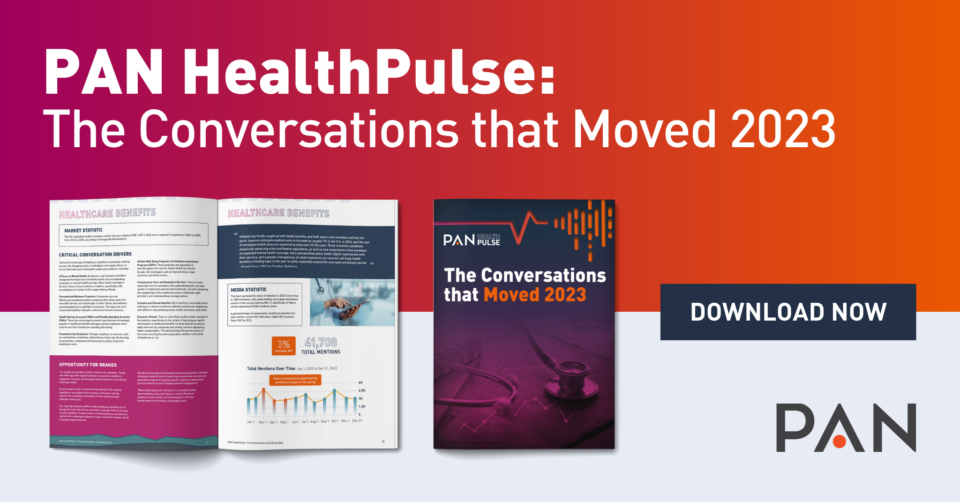Given the year healthcare had in 2023, the old adage of looking back to look ahead seems to make perfect sense in order to get some perspective.
The Financial Picture
It’s no secret that 2023 was tough one for the healthcare industry as a whole. According to Rock Health, annual venture funding within the digital health sector closed out at $10.7B, down from $15.3B in 2022 and the lowest amount of capital invested in U.S.-based digital health startups since 2019. And, according to the 2023 HSBC Venture Healthcare Report, biopharma companies raised approximately $22.9 billion in venture capital deals, representing a 23% decrease from 2022, with early-stage/first venture capital financings hit harder than later-stage financings.
Early Indicators
But, there were certainly early warning signs there could be tougher sledding ahead well before the calendar flipped from 2022 to 2023. In fact, 2022 was the year of inflation (the global rate of inflation finished the year at 9%), stock drops (Wall Street’s worst year since 2008, S&P 500 finished down nearly 20%), and a total of seven rate hikes — all of which combined to indicate a recession was a strong possibility.
Yet, 2023 started off with signs that it could be a rebound year. January and February funding numbers began to suggest that sector investment was slowly but surely inching back upwards — according to Rock Health, U.S. digital health funding closed with $3.4B across 132 deals, with an average deal size of $25.9M. On the biopharma side, according to various analysts, private companies raised $3.3B of VC financing in Q1. Inflation was easing slightly. Investors and entrepreneurs alike were rediscovering their confidence, signaling a sense of optimism across healthcare sectors.
However, the March news cycle — the collapse of Silicon Valley Bank, the seizure of Signature Bank, Moody’s downgrading of bank credit ratings, and yet another Fed rate hike — quickly put a damper on things and set the stage for what was to unfold over the next 10 months. But, despite the overall financial challenges and repercussions in the world of healthcare, there were some promising bright spots, including an uptick in M&A activity across the healthcare sector, most notably CVS Health purchased Oak Street Health for $10.6 billion. A Kaufman Hall year-end analysis revealed a substantial increase in merger and acquisition with 65 announced transactions compared to the previous year’s 53 (the report does note that 28% of these deals were a direct result of the prominent financial distress facing the industry, up from 15% in 2022). In a tough market laden with economic uncertainty and headwinds, it was more critical than ever for brands across HIT and life sciences to pivot their communications strategies and tactics with a focus on both demand gen activities as well as leaning in to the many noteworthy topics and trends in 2023 that altered the industry and set the stage for the years ahead.
2023: A Wild and Crazy Ride
In the words of Charles Dickens, “It was the best of times, it was the worst of times.” Not all bad but not great either. Tumultuous. Highs and lows. Ups and Downs. All good ways to categorize the year that was 2023.
AI Joins the Party
Falling in to the ‘not all bad’ category, although officially launching in November of 2022, ChatGPT (and AI) really took the main stage in healthcare throughout 2023. As noted in my early 2023 blog post and our subsequent 2023 PAN HealthPulse Report, AI finally started to push past the “buzz word” categorization and showed tangible impact across digital health and HealthIT within the payer and provider sectors specifically as well as life sciences. Adding credibility to AI and Generative AI, in October, President Biden, signed an executive order to establish the first set of standards for using AI in healthcare (and other industries) and help find balance between managing potential risks of AI while encouraging innovation that can benefit patients/consumers.
Long-Term Innovation in Life Sciences
Another bright spot was the pace of digital transformation, spurred by COVID-19, which continued to reshape the life sciences landscape. We saw companies move from slow or reactionary adoption to deliberate, strategic integration of advanced technologies, focused on advancing R&D and process efficiency — as well as improving data quality in an effort to become more data-driven — drug discovery, personalized medicine, and enhancing clinical trials. Also, within pharma and life sciences, the government capped the price of insulin and began discussions about negotiating brand drug prices for Medicare enrollees.
Movement of the Value-Based Care Needle
We also saw continued adoption of value-based care (VBC) models across a growing spectrum of payment models. Rising costs of care have put pressure on stakeholders while key VBC enablers have matured — including data availability, analytics, and care management models. Regulatory forces also spurred growth. Speaking of adoption, we also saw continued traction within telehealth usage, specifically for mental and behavioral health, and further member engagement and experience initiatives and efforts from health plans.
Staffing for Success: Challenges & Opportunities
On the flip side, in addition to slowed funding, we saw—and felt—the impact of staffing shortages and clinician burnout within the care delivery setting. The Bureau of Labor Statistics projects that the country will face a shortage of 195,400 nurses by the year 2031, and that the number of openings for home health aides and personal health aides will increase 37% by 2028. In addition, the U.S. is expected to suffer a shortage of up to 124,000 physicians in the next 12 years, according to a report from the Association of American Medical Colleges. These staffing shortages coupled with rising inflation and the end of PHE funding and flexibilities put a significant financial strain on hospital and health systems as 2023 progressed. Hopefully starting to positively impact this potential staffing shortage, in 2023 the healthcare industry added more than 650,000 jobs; growing at its fastest rate in more than three decades, according to a report from research consultancy Altarum.
And, within the biopharma space layoffs continued across the sector — a major workforce reduction from Biogen in July as part of a “fit for growth cost savings initiative (1,000 jobs or approx. 11% of its employees) and another smaller reduction of 113 employees in the Fall as well as a 600 total headcount layoff by Pfizer in the UK and Ireland which was a result of a bigger than expected COVID cliff. In total more than 150 drug companies laid off employees throughout 2023.
That all said, as we look ahead to 2024, we can likely expect to continue to take the good with the bad as there is certainly some trepidation across the industry and within key sectors. However, there should be some continued bright spots from an innovation and adoption standpoint.
What’s in Store for 2024
At the one-month marker, from a macro-financial level within HealthIT/digital health, the consensus seems to be that 2024 will be a year of further recalibration that balances out the funding highs dating back to 2021 and the lows that were hit in 2023. Also, consolidation via companies that shut down due to lack of current runway or inability to raise new rounds and those that take the exit route (public or M&A; likely at a lesser value). I’ve always said that the market hates uncertainty, and 2024 looks to be filled with uncertainty — the presidential election looms, there is existing pressure on federal government finances from large budget deficits and the impact of higher interest rates on federal debt servicing costs.
In addition, the healthcare industry faces uncertainty about the financing of Medicare and Medicaid; regulation, including views about horizontal and vertical integration; and overall industry economics. Within biopharma sector, there is also a strong sense of guarded optimism with some early signs of a turnaround — a rebounding market and a recent flurry of pharma company acquisitions. Hope springs eternal with the surging demand for new obesity drugs that has lifted Eli Lilly and Novo Nordisk, while sparking others across the industry to follow. The FDA may soon approve a new Alzheimer’s drug and there is also some promise around new treatments for certain cancers. All of which brings us back to the theme of guarded optimism.
As we look into our crystal ball at themes and trends which could be prominent in 2024, here are a few thoughts below and you can also check out our refreshed PAN HealthPulse Report which goes deeper into these trends and surfaces additional ones. It will be critical for brands in 2024 to capitalize on those themes relevant to their businesses and markets with key executive and subject matter expert insights and POVs to stay relevant, position as thought leaders, and build awareness:
- Patient Experience: With the rise in popularity of wearables and other mobile technologies, we should continue to see the industry improve the patient experience by embracing preventative self-care. By 2030, the patient engagement market is expected to surpass $69.25 billion. In 2024 hospitals and health systems will even further integrate these data-driven technologies. Additionally, reducing friction points for patients by further simplifying processes with automation— scheduling, billing, accessing health info, etc. — can create a seamless experience, encouraging patients/consumers to return for care.
- Generative AI: It’s no secret that the healthcare industry lags far behind other industries in the adoption of AI, but in 2024 we should see further adoption of GenAI to accelerate the application of digital and automation in healthcare. According to McKinsey, “Given the need for empathetic and intelligent interactions in a service industry such as healthcare, the recognition, comprehension, and content creation capabilities of gen AI represent a major opportunity.”
- Specialty Pharmacy: Specialty pharmacy is one of the fastest growing subsegments within pharmacy services, currently accounting for 40 percent of prescription revenue and, according to some industry analysts, expected to reach nearly 50 percent of prescription revenue in 2027. Growth in specialty pharma will be driven by various factors but perhaps most significantly, the continued expansion of pipeline therapies (e.g. cell and gene therapies, and oncology and rare disease therapies).
- Mental/Behavioral Health: Behavioral and mental health are no longer taboo phrases with negative connotations that must be buried or overlooked. Behavioral health is one of the largest healthcare media conversations today. The digital mental/behavioral health space was growing rapidly even before the COVID-19 pandemic, but stress and anxiety brought on by the health crisis continues to exacerbate the demand for virtual behavioral health services. Continued delivery platforms as well as reimbursement will be top-of-mind in 2024.
- Data & Analytics: As both HIT/digital health and biopharma/life sciences companies continue to make strides with streamlining processes and operations, making more informed decisions, engaging patients, improving care, reducing costs, getting drugs and therapies to market faster, and personalizing care, data and analytics will sit at the center and serve as the backbone to facilitating all of that and more. The basic foundation of high-quality data that enable and amplify human-driven processes is in place already, and in the coming year efficiency and automation will take center stage to maximize constrained resources and allow for the needed innovations and improvements to advance.
Going to ViVE and/or HIMSS? We’ll be there and would love to talk about the trends driving conversations across today’s healthcare landscape and hear about your brand awareness and lead generation needs. We’ve partnered with hundreds of leading healthcare brands to help them achieve their business goals and reach their next stage(s) of growth. Check us out!




